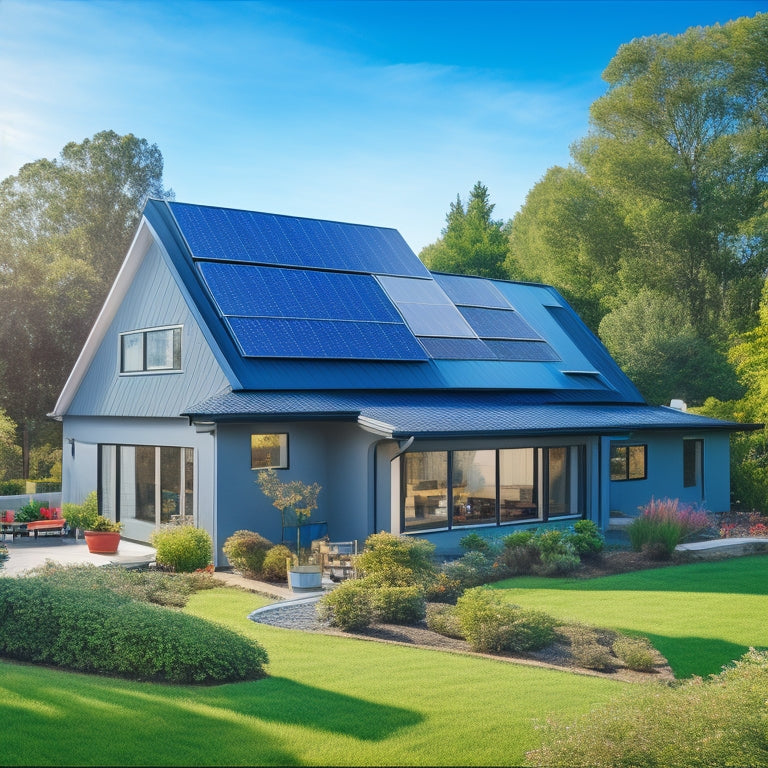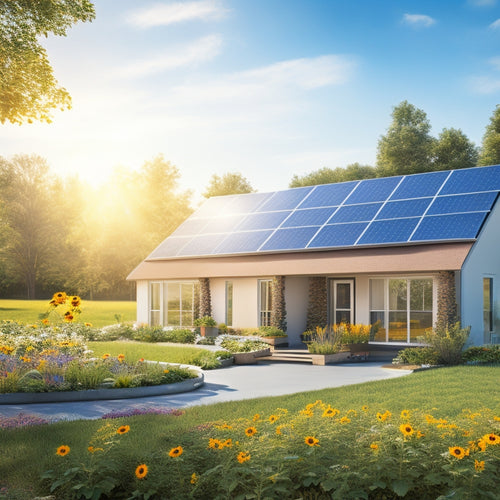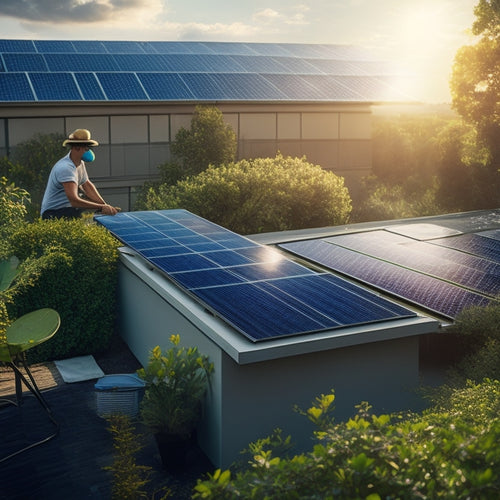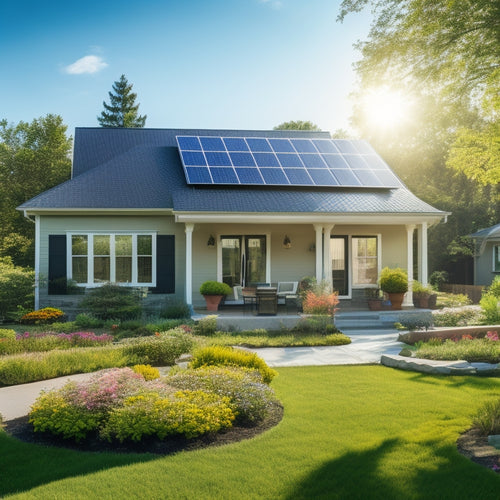
What Are the Top Solar Cells to Purchase for Home Use
Share
You're likely overwhelmed by the vast options available, but focusing on top brands like Panasonic, SunPower, and Tesla, which offer high efficiency and reliable warranties, can narrow down your search. Consider panel efficiency, durability, and customer support when selecting a brand. High-efficiency models often boast conversion rates above 20%, making them ideal for limited roof space. By understanding the key factors that determine a solar cell's performance, you'll be well-equipped to make an informed decision - and there's more to investigate when it comes to finding the perfect solar cells for your home.
Key Takeaways
- Leading brands like Panasonic, SunPower, and Tesla offer high-efficiency solar cells with extensive warranties and durable designs.
- High-efficiency solar cells (above 20%) are ideal for small roof spaces, providing higher energy yields and reduced maintenance costs.
- Consider panel efficiency, durability, and customer support when selecting a brand, as well as investments in research and development.
- Bifacial and transparent solar cells offer advanced features, increasing energy output and aesthetic appeal, while polycrystalline and thin-film options provide cost-effectiveness.
- Customization based on roof size, energy usage, and budget is crucial, with monocrystalline and bifacial solar cells recommended for small homes.
Top Brands for Solar Cells
Several top brands dominate the solar cell market, offering high-quality products that cater to various needs and budgets. As you investigate the top solar brands, you'll notice that they're constantly pushing the boundaries of solar technology trends. Companies like Panasonic, SunPower, and Tesla are leading the charge, boasting impressive efficiencies and warranties that guarantee maximum energy output.
When selecting a top solar brand, you'll want to take into account factors like panel efficiency, durability, and customer support. Look for brands that offer high-efficiency panels with low degradation rates, assuring your system maintains its performance over time.
Additionally, examine brands with extensive warranties that cover both parts and labor. You'll also want to research brands that invest heavily in research and development, as they're more likely to stay ahead of the curve regarding solar technology trends.
Understanding Solar Cell Efficiency
When you're shopping for solar cells, you'll likely come across efficiency ratings that claim to measure their energy-harnessing prowess.
But what do these ratings really mean, and how are they calculated?
You'll want to understand the different methods used to measure efficiency, as well as strategies for maximizing energy output, to make an informed decision.
Efficiency Measurement Methods
One key aspect of evaluating solar cells for home use is understanding how their efficiency is measured. You need to know how manufacturers determine the efficiency of their solar cells to make informed purchasing decisions. Efficiency measurement methods are standardized to guarantee consistency across the industry.
-
Standards like IEC 61215 and UL 1703 provide guidelines for efficiency testing, confirming that manufacturers follow the same procedures.
-
Efficiency testing involves measuring the maximum power output of a solar cell under standardized conditions, such as temperature and irradiance.
-
The measurement standards also specify the testing environment, including the range and intensity of the light source.
By understanding these measurement methods, you can compare the efficiency of different solar cells and make informed decisions about which ones to purchase for your home.
When evaluating solar cells, look for manufacturers that adhere to these standards and provide transparent efficiency ratings. This guarantees that you're getting a high-quality product that will meet your energy needs.
Maximizing Energy Output
Now that you're equipped with a solid understanding of efficiency measurement methods, it's time to investigate the actual efficiency of solar cells and how to maximize their energy output.
To get the most out of your solar panels, you'll want to focus on enhancing their orientation and placement. Proper solar panel orientation is vital, as it directly affects energy production. Ideally, your panels should face south (in the northern hemisphere) and be tilted between 30-40 degrees to capture the most sunlight.
Conducting a shading analysis is also important to identify any potential obstructions that could reduce energy output. This involves evaluating the surrounding environment to identify trees, buildings, or other structures that might cast shadows on your panels.
Cost-Effective Solar Cell Options
By incorporating cost-effective solar cell options into your home's renewable energy system, you can maximize your return on investment while minimizing your carbon footprint.
With the right budget-friendly options, you can reduce your reliance on the grid and enjoy significant savings on your energy bills.
When selecting cost-effective solar cells, consider the following key factors:
-
Polycrystalline silicon solar cells: A more affordable option that still offers high energy conversion rates.
-
Thin-film solar cells: Uses less material, reducing production costs and making them a budget-friendly choice.
-
Bifacial solar cells: Can absorb light from both sides, increasing energy output without increasing installation costs.
- Used or refurbished solar cells: A cost-effective option for those on a tight budget, but be sure to check the warranty and performance guarantees.
High-Efficiency Solar Cell Models
You're looking for high-efficiency solar cell models that can maximize your energy output.
These models boast advanced technology features, such as multi-busbar or PERC designs, which enable higher energy production per unit area.
With high conversion efficiency ratings, these solar cells can generate more power from the same amount of sunlight, making them an attractive option for your home.
Maximum Power Output
Most high-efficiency solar cell models can achieve maximum power outputs ranging from 300 to 400 watts, markedly outperforming standard solar panels. This increased power output is made possible by recent solar panel advancements, which have led to more efficient energy conversion rates.
As a result, you can generate more power with fewer panels, reducing the overall cost of your solar energy system.
Some key benefits of high-efficiency solar cells with maximum power output include:
- Higher energy yields per unit area, reducing the need for large installations
- Improved performance in low-light conditions, ensuring consistent energy generation
- Enhanced compatibility with energy storage solutions, allowing for more efficient energy management
- Increased durability and longer lifetimes, reducing maintenance and replacement costs
Advanced Technology Features
High-efficiency solar cell models boast advanced technology features that enable them to achieve maximum power output. These features can greatly enhance the performance of your solar panel system, giving you more power and energy savings.
One such feature is bifacial technology, which allows the solar cells to capture energy from both the front and back sides of the panel. This results in up to 25% more energy output compared to traditional solar cells.
Another advanced feature is transparent solar technology, which integrates solar cells into windows and building facades, providing both energy generation and transparency. This technology is ideal for buildings with limited roof space or for those who want to generate energy while maintaining a sleek, modern design.
When shopping for high-efficiency solar cells, look for models with advanced technology features like bifacial technology and transparent solar. These innovations can help you maximize your energy output and reduce your carbon footprint.
High Conversion Efficiency
Three parameters determine a solar cell's efficiency: open-circuit voltage, short-circuit current, and fill factor. When choosing high-efficiency solar cells for your home, you want to maximize these parameters to get the most power out of your system.
High-efficiency solar cell models boast impressive conversion rates, often above 20%. This means more energy harvested from the sun and less space required for your solar panel installation.
-
Higher energy yields: High-efficiency solar cells generate more power per hour of sunlight, making them ideal for homes with limited roof space.
-
Improved temperature coefficient: These solar cells maintain their efficiency even in high temperatures, guaranteeing consistent performance throughout the day.
-
Enhanced durability: Advanced materials and manufacturing processes guarantee these solar cells last longer and withstand environmental stressors.
- Seamless energy storage integration: High-efficiency solar cells pair perfectly with energy storage systems, allowing you to store excess energy for later use.
Best Solar Cells for Small Homes
Your small home deserves a solar panel system that's customized to its unique needs. When selecting the best solar cells for your small home, consider factors like roof size, energy usage, and budget.
Look for solar cells with high power density to maximize energy production in limited space. For small homes, monocrystalline or bifacial solar cells are ideal due to their high energy conversion rates.
Installation tips are essential for optimal performance. Make sure your solar panels are installed at the correct angle and direction to capture maximum sunlight.
Regular solar cell maintenance is also vital to prevent energy loss. Clean your panels regularly to remove debris and dirt that can reduce efficiency.
Additionally, monitor your system's performance to identify potential issues early on. By choosing the right solar cells and following proper installation and maintenance practices, you can enjoy significant energy savings and a reduced carbon footprint.
Solar Cells With Long Warranties
When you're investing in solar cells for your home, you want to guarantee they'll perform well for years to come.
That's why you should look for solar cells with long warranties that offer extended warranty options and reliable performance guarantees.
Extended Warranty Options
Reliability is a top concern for homeowners investing in solar cells, and an extended warranty can provide peace of mind. When shopping for solar cells, you'll want to look for manufacturers that offer thorough warranty coverage and a lengthy warranty duration. This guarantees that you're protected in case your solar cells malfunction or degrade prematurely.
-
25-year warranty coverage: Look for manufacturers that offer at least 25 years of warranty coverage on their solar cells. This provides a quarter century of protection against defects and performance issues.
-
Linear performance warranty: A linear performance warranty guarantees that your solar cells will maintain a certain level of energy output over time. This type of warranty typically covers 25 years or more.
-
10-year workmanship warranty: A 10-year workmanship warranty covers labor costs associated with repairing or replacing defective solar cells.
- Optional extended warranty: Some manufacturers offer extended warranty options that can be purchased separately, providing additional protection beyond the standard warranty duration.
Reliable Performance Guarantee
High-quality solar cells backed by lengthy warranties instill confidence in homeowners investing in renewable energy. You want to ascertain that your solar cells will perform at their best for years to come, and a reliable performance guarantee provides that assurance.
When evaluating solar cells, look for manufacturers that offer extensive warranty coverage with a minimum of 25 years of performance longevity. This warranty should cover both the product and its performance, guaranteeing a certain level of energy output over the warranty period. A reliable performance guarantee also indicates the manufacturer's commitment to quality and their confidence in their product's ability to withstand the elements and continue performing at a high level.
Top-tier manufacturers typically offer industry-leading warranties, often with a 30-year or more performance guarantee. This extended warranty coverage provides you with peace of mind, knowing that you're protected in case your solar cells underperform or experience technical issues.
Top-Rated Solar Cells for Beginners
By diving into the world of solar energy, you're taking the first step towards reducing your carbon footprint and saving on your electricity bills.
As a beginner, it's vital to choose top-rated solar cells that meet your energy needs and fit your budget.
When selecting solar cells, consider the following key factors:
-
Efficiency rating: Look for cells with high efficiency ratings (above 20%) to maximize energy production.
-
Durability: Choose cells with a durable design and high-quality materials to guarantee a long lifespan (25+ years).
-
Warranty: Opt for cells with a thorough warranty (25+ years) that covers performance and defects.
- Installation and maintenance: Consider cells with easy installation tips and simple maintenance practices to minimize upkeep costs.
Comparing Monocrystalline Solar Cells
In the pursuit of utilizing solar energy, monocrystalline solar cells have emerged as a popular choice for homeowners. You're likely considering them for their high efficiency rates and sleek appearance. As you weigh your options, it's vital to understand the monocrystalline advantages.
These cells boast higher power output per hour of sunlight, making them ideal for smaller roof spaces. They also perform better in low-light conditions, ensuring you generate power even on cloudy days. Additionally, monocrystalline cells have a longer lifespan, typically lasting up to 30 years or more.
However, it's important to acknowledge the monocrystalline drawbacks as well. The manufacturing process is more complex, making them more expensive than other options. They're also more prone to thermal expansion, which can lead to cracks and reduce their efficiency over time.
Moreover, monocrystalline cells can be more sensitive to shading, meaning even small obstructions can greatly impact their performance. By understanding both the advantages and drawbacks, you can make an informed decision about whether monocrystalline solar cells are the right choice for your home.
Polycrystalline Solar Cell Benefits
While monocrystalline solar cells boast impressive efficiency rates, polycrystalline solar cells offer an attractive alternative for homeowners.
You'll find that polycrystalline solar cells provide several advantages that make them an excellent choice for your home.
Some of the key benefits of polycrystalline solar cells include:
-
Cost-effectiveness: Polycrystalline solar cells are generally cheaper to produce than monocrystalline cells, making them a more affordable option for homeowners.
-
Environmental benefits: The production process of polycrystalline solar cells has a lower environmental impact compared to monocrystalline cells, reducing waste and energy consumption.
-
Durability: Polycrystalline solar cells are more resistant to heat and can withstand extreme temperatures, making them suitable for various climates.
- Efficiency: While not as efficient as monocrystalline cells, polycrystalline solar cells still offer a high conversion rate of sunlight into electricity, making them a reliable choice.
Solar Cells With High Durability
When it comes to withstanding the elements, homeowners need solar cells that can take a beating. You're investing in a system that'll be exposed to harsh weather conditions, so durability is essential.
Solar cells with high durability guarantee a longer solar cell lifespan, reducing the need for frequent replacements or repairs.
Look for solar cells with a high weather resistance rating, typically measured by the International Electrotechnical Commission (IEC). A higher rating indicates the solar cells can withstand extreme temperatures, humidity, and UV radiation.
For example, a rating of IEC 61215:2016 guarantees the solar cells can operate efficiently in temperatures ranging from -40°C to 85°C.
Top manufacturers like Trina Solar, Hanwha Q CELLS, and LONGi Solar offer high-durability solar cells with weather resistance ratings that meet or exceed industry standards.
These solar cells are built with sturdy materials and undergo rigorous testing to guarantee they can withstand the elements.
Frequently Asked Questions
Can I Install Solar Cells Myself, or Do I Need a Professional?
You can attempt a DIY installation, but weigh the risks: improper connections can spark fires, and roof falls can be fatal. Guarantee your safety by considering professional installation, as they'll handle complex wiring and rooftop guidance.
Will Solar Cells Work During Power Outages or at Night?
You'll need a solar battery to store excess energy during the day, which you can draw from during power outages or at night, but if you're grid-connected, your system will shut down for safety reasons, so consider a hybrid inverter for backup power.
Are Solar Cells Resistant to Extreme Weather Conditions?
Like a fortress, your solar cells stand strong against Mother Nature's fury, boasting durability and weather resistance that guarantees they'll capture energy tirelessly, even in the face of torrential rains, scorching heat, and fierce winds.
Can I Use Solar Cells in Areas With Partial Shading?
You can mitigate partial shading's impact on solar cells by implementing shading solutions, like bypass diodes or micro-inverters, which optimize panel efficiency; however, it's vital to assess the shading pattern to determine the most effective solution for your specific installation.
Do Solar Cells Require Regular Maintenance or Cleaning?
You'll need to perform regular solar panel upkeep, including cleaning, to guarantee peak energy production; using gentle cleaning techniques, like soft-bristled brushes and mild soap, will help maintain your system's efficiency and prolong its lifespan.
Conclusion
As you steer through the vast solar cell market, remember that choosing the right one is like finding a puzzle piece that fits your unique needs. You've weighed efficiency, cost, and durability; now, it's time to utilize the power of the sun. With the top brands, models, and types outlined above, you're ready to shine bright, illuminating your path to a sustainable future.
Related Posts
-

Home Solar Systems for Environmental Impact
Home solar systems markedly reduce your carbon footprint by utilizing renewable energy. By adopting solar energy, you...
-

Green Ways to Maintain Solar Panels
To maintain your solar panels sustainably, start with regular inspections to catch potential issues early, enhancing ...
-

Affordable Solar Panels for Home Use
Affordable solar panels offer you a smart way to cut down on energy costs while promoting sustainability. With govern...


